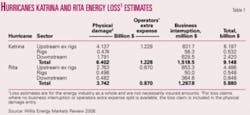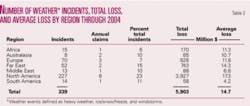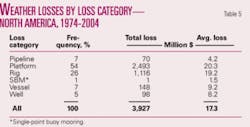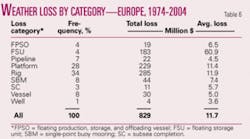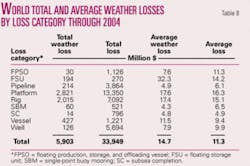The third and final part of this series examines the impact of weather on offshore losses.
Weather plays a major role in human activities offshore, and extreme weather in particular is one of the significant perils encountered. Storms and hurricanes regularly challenge and endanger the offshore energy industry, exposing their insurers, owners, and investors to significant capital loss.
A statistical assessment of weather damage and loss, broken out by region, time, and loss category is presented for the time horizon 1970-2004 based on the Willis Energy Loss database. We begin with a summary review of the 2005 hurricane season.
2005 gulf hurricanes
The 2005 hurricane season in the Gulf of Mexico was the worst in the history of offshore production and the most destructive and costliest natural disaster in the history of the US.
Hurricanes Katrina and Rita destroyed 136 structures, representing 1.7% of gulf oil production and 0.9% of natural gas output. Another 53 platforms suffered significant damage. Five rigs were destroyed, and 19 rigs sustained significant damage.7 10 11
Out of a total of $15 billion of energy losses, about $2 billion is applicable to the downstream sector (Table 1). Two-thirds of the loss estimates are due to physical damage, followed by business interruption (18%) and operators extra expense (14%).
Onshore losses as a whole were significantly smaller than the offshore sector. For Katrina, losses are estimated at $2.53 billion onshore, $6.63 billion offshore. Rita losses are estimated at $915 million onshore, $4.98 billion offshore.
Weather losses by region
Next, consider the number of weather incidents, annual claims, total weather loss, and average weather loss by world region (Table 2).
North America has the greatest total loss due to weather events and the largest percentage of total incidents, followed by Europe and the Far East.
North America also has the largest number of loss claims per year. In North America, the overall indexed loss from 1974 to 2004 totaled nearly $4 billion, or on average, $131 million/year. The average loss per claim in North America was $17.3 million.
Europe and the Far East realized insured losses of $828 million and $743 million, and in total, North America, Europe, and the Far East sustain over 93% of the total weather losses in the world. The average cost per insured event ranged from $4.2 million (South America) to $17.3 million (North America). The world average for insured weather-related loss was $14.7 million.
The average weather loss in the Gulf of Mexico exceeded the average world weather loss, indicating the high weather risk from operating in the region. In other regions of the world such as the Middle East and South America, weather loss is significantly less than the average loss. In Europe and Africa, weather loss is comparable to the average loss.
Weather loss distribution
The distribution of weather-related insurance losses by region is another consideration (Table 3). For most offshore regions, the data depicts a high frequency/low severity trend.
Although the vast majority of events are smaller than $20 million, these events only contribute about one-fourth of the total indexed loss.
One-fourth of the total losses are low frequency/high severity occurrences ($100+ million) that characterize catastrophic events.
Seasonal weather impact
Weather events may have a seasonal component, such as in the occurrence of tropical cyclones in the Gulf of Mexico and South China Sea or severe storms that occur throughout the year as in the North Sea.
Seventy-five percent of all North American events occur in August-October and comprise over two-thirds of the total indexed loss (Table 4). North Sea events occur throughout the year except for a brief summer lull.
Losses by category
In North America, offshore losses from platforms and rigs accounted for nearly 92% of the total indexed loss recorded and resulted in the average loss per claim of $17.3 million (Table 5).
In Europe, platforms, rigs, and floating storage units accounted for 84% of the total weather-related losses (Table 6). Floating storage units sustained the greatest average loss ($60.9 million), but the low frequency does not provide a reliable estimate for expected loss. Platform and rig losses are comparable.
In the Far East, rigs and vessels sustain the majority of the weather losses (80%), with an average loss of $28.4 million for rigs and $15.8 million for vessels (Table 7).
null
World totals and averages
The world total losses and total weather loss is depicted in Table 8, along with average loss and average weather loss, per category. Weather losses comprise about 17.4% total insured losses, and on average, yield somewhat larger losses relative to other events.
null
Acknowledgment
Andrew Jackson, Willis Global Markets (www.willis.com), provided comments and critique of this study.
References
- Sharp, D.W., “Offshore Oil and Gas Insurance,” Witherby & Co. Ltd., London, 2000.
- Willis Energy Market Review, May 2006 (www.willis.com).
- Gerwick, B.C., “Construction of Marine and Offshore Structures,” 2nd ed., CRC Press, Boca Raton, Fla., 2000.
- Banks, E., “Catastrophic Risk,” John Wiley & Sons Ltd., West Sussex, England, 2005.
- Graff, W.J., “Introduction to Offshore Structures,” Gulf Publishing Co., Houston, 1981.
- Mather, A., “Offshore Engineering: An Introduction,” 2nd ed., Witherby & Co. Ltd., London, 2000.
- Wisch, D.J., “Observations of hurricane impacts on deepwater facilities,” Offshore Technology Conference, OTC 18414, Houston, 2006.
- ABS Guidance Notes on Rock Assessment: Chapter 5, Offshore oil and gas systems, hazards and safety regulations, 2000.
- Swiss Re, “Natural catastrophes and reinsurance,” Swiss Re Publishing, Zurich, 2003.
- Coyne, M., et al., “Shell pipeline’s infrastructure recovery after Hurricanes Katrina and Rita,” Offshore Technology Conference, OTC 18423, Houston, 2006.
- Sharples, B.P.M., and Buffington, S., “MODU performance in Hurricane Ivan,” Offshore Technology Conference, OTC 18322, Houston, 2006.
Bibliography
API RP 2A, “Planning, Design, and Constructing Fixed Offshore Platforms,” American Petroleum Institute, Dallas, 2000.
